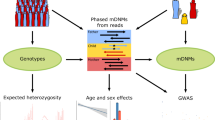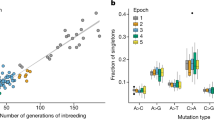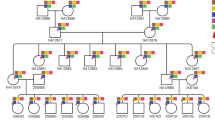Abstract
We have analysed close to 30 000 human germline transmission events at five microsatellite loci (D3S1359, HumTH01, HumvWA, HumTPO and HumFES) and four minisatellite loci (D1S80, ApoB, Col2A1 and D17S30). At these loci the mutation rates are similar at the microsatellite and the minisatellite loci, varying from 0.2 × 10−3 to < 3.3 × 10−3 and from 0.5 × 10−3 to 1.5 × 10−3, respectively. Interestingly, paternal mutations appeared to be dominant at the microsatellite loci, whilst maternal mutations are dominant at minisatellite loci. Based on our data, no unequivocal support for a strict strand-slippage mutation mechanism (gain or loss of a single repeat) was found, although the vast majority of the mutational events were small gains or losses of one to three repeats, and only few unequivocal large gains or losses were observed.
Similar content being viewed by others
Log in or create a free account to read this content
Gain free access to this article, as well as selected content from this journal and more on nature.com
or
Author information
Authors and Affiliations
Corresponding author
Rights and permissions
About this article
Cite this article
Sajantila, A., Lukka, M. & Syvänen, AC. Experimentally observed germline mutations at human micro- and minisatellite loci. Eur J Hum Genet 7, 263–266 (1999). https://doi.org/10.1038/sj.ejhg.5200257
Received:
Revised:
Accepted:
Published:
Issue date:
DOI: https://doi.org/10.1038/sj.ejhg.5200257
Keywords
This article is cited by
-
Population genetics and evolutionary history of the endangered Eld’s deer (Rucervus eldii) with implications for planning species recovery
Scientific Reports (2021)
-
Mutational Dynamics of Microsatellites
Molecular Biotechnology (2010)
-
Haplotype-assisted characterization of germline mutations at short tandem repeat loci
International Journal of Legal Medicine (2010)
-
Genetic characterization of a new set of recombinant inbred lines (LGXSM) formed from the intercross of SM/J and LG/J inbred mouse strains
Mammalian Genome (2006)
-
Recommendations for animal DNA forensic and identity testing
International Journal of Legal Medicine (2005)



